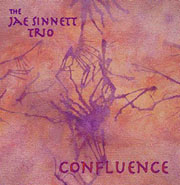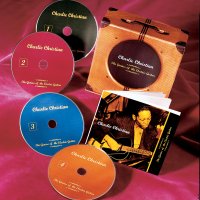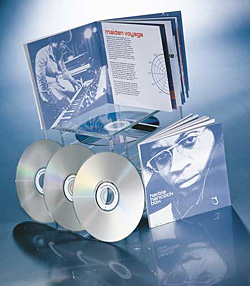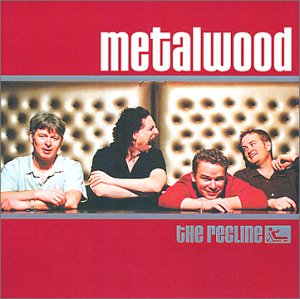 Jae Sinnett Trio
Jae Sinnett Trio
Confluence (J-Nett)
Jae Sinnett’s been putting out recordings since 1986 and has fronted his own jazz trio for many years, yet Confluence, his seventh album, is the first he’s recorded in the trio format. It’s his best work yet.
Bassist Terry Burrell and pianist Alan Farnham have accompanied Sinnett for the past seven years, playing festivals, clubs and universities with him. They were the rhythm section for the drummer’s last two recording projects. That time together as a working band pays off handsomely in the musical riches showcased on this disc.
Confluence kicks off with a reworking of “Old Devil Moon.” After Farnham’s opening McCoy Tyner-like chordal statement, the first thing you notice is the extra note thrown into the melody of this well-worn standard---the trio’s laying down a fresh 5/4 time signature that is far beyond “Take Five.” After a one-verse statement of the theme, the pianist is off on an invigorating ride that continues in the Tyner style of fat voicings and aggressive keyboard-length runs. Man, this is hot!
Sinnett’s drum showcase “Six and Smith” travels through several dimensions, always returning to its “You Can’t Hurry Love” bassline between and within solo workouts for piano and drums. Farnham wrote the jaunty “Brother B” for Burrell, and the bassist rips up his five-string when the spotlight shifts his way. The trio then shows its softer side on the chestnut, “As Time Goes By,” before swinging gently through the mellow Farnham original, “Nairda.”
Three Sinnett compositions close the disc. The first, “Theme for Jobim,” tips its hat to the great Brazilian composer in ways more subtle than the title would imply, the melody hinting at familiar touchstones while the rhythm drives harder than any heard on the beach at Ipanema. “Helen’s Rose” is a beautiful ballad on which the threesome conjures up images of the Bill Evans Trio. Finally, the band heads “Straight Around the Corner” to end the show with controlled abandon.
As always, Sinnett is generous in showing off his playing partners, and this time out Allen Farnham, in particular, is superb. The breadth of his piano playing is amazing. He locks in tightly with Sinnett and Burrell to make Confluence an impressive outing.
__________
 Charlie Christian
Charlie Christian
The Genius of the Electric Guitar (Columbia Legacy)
This four-disc set has been called “the boxed set of the year” in many quarters, and for good reason. Charlie Christian was one in a long line of musical innovators who died young, in his case at age 25 from tuberculosis. Although his recording career lasted only seventeen months, his influence can be heard in every electric jazz guitarist since, and extends into the guitar lexicon of rock, pop and the blues.
Christian was discovered in Oklahoma by legendary talent scout/producer John Hammond, who arranged a tryout in L. A. with bandleader Benny Goodman. Shortly thereafter, the guitarist was in the recording studio with Goodman’s sextet, laying down the classic “Flying Home.” Genius begins with that session, collecting the recordings Christian made with Benny Goodman between October, 1939 and March, 1941. The first three discs are devoted to his work with various incarnations of the sextet and septet, and the final disc rounds up his three tracks with Goodman’s full orchestra, a Metronome all star session, plus assorted odds and ends.
Prior to Christian, the guitar was used almost exclusively as a rhythm instrument in jazz, laying down chords and keeping the beat while others, primarily hornmen, played the melodies and took the solos. Christian combined single note lines and rhythmic complexity to create a new language and location for the guitarist within the jazz setting. Listening to these recordings, you can hear the ghosts of all the guitar greats of the last sixty years.
Just as amazing to those of us too young to have experienced the swing era first hand is the clarinet playing of Benny Goodman. Sure, he was the “king of swing” and led one of the greatest big bands of the era. But within the context of these small-group recordings, Goodman’s work on the licorice stick is nothing short of astonishing. These sides also reveal the virtuosity of vibraphonist Lionel Hampton.
It’s an incredible band, and a superb collection that is essential listening for any jazz fan.
__________
 Herbie Hancock
Herbie Hancock
The Herbie Hancock Box (Columbia Legacy)
When I think of Herbie Hancock’s years on Columbia Records from 1973-88, I think primarily of his funk-propelled fusion albums of the mid-‘70s, Headhunters, Thrust and Manchild, and his 1980s experiments in electronica, Future Shock and Perfect Machine. However, as this collection makes clear, Hancock also spent a good portion of the period playing acoustic music with longtime musical pals like Wayne Shorter, Freddie Hubbard, Ron Carter and Tony Williams.
The first two discs of this four-CD set are devoted to this acoustic, straightahead material, much of it gleaned from albums that were originally released only in Japan. Often performing under the group name of VSOP, Hancock and friends revisit tunes from their time with Miles Davis, and reinterpret some of Herbie’s compositions from his ‘60s Blue Note dates. He appears in solo, duo, trio, quartet and quintet configurations, primarily in concert settings, and the music is as good as live jazz gets.
The second half of this boxed set showcases the funk and electronic music that made Hancock a best selling crossover artist. I personally passed on most of the post-Manchild albums, and initially dismissed some of the choices selected for inclusion here. However, The Box introduced me to some interesting late-70s/early ‘80s tracks with which I was unfamiliar, like “Calypso” from Mr. Hands and “Spider” from Secrets. And of course, there’s the video-propelled mega-hit, “Rockit.”
Herbie Hancock has always been a musical adventurer, a “Chameleon” (to borrow the title of one of his best known pieces included here) in search of new surroundings and new challenges. The Herbie Hancock Box is a document of some of his most inspired journeys.
A quick note about the packaging---It’s a Lucite box with shelves for each of the four discs, plus one for the fascinating booklet built around Herbie’s remembrances. It’s cool, but it’s hard to open and close, and it takes up too much space in your CD bookcase.
__________
 Metalwood
Metalwood
The Recline (Telarc)
Some prognosticators predict the future of jazz lies in the hands of groove-oriented jam bands like Medeski, Martin & Wood and guitarist John Scofield’s group. Their blend of rock, funk and hip-hop with improvisational jazz sensibilities reminds me of the convergence of styles that created the fusion movement of the 1970s.
Unfortunately, a lot of this new genre’s music is just what the “jam band” label implies---lengthy, formless jams built upon the flimsiest of melodic and chordal foundations. It may be fun for the noodling musicians and the spinning dancers in the crowd, but it doesn’t hold up too well as a listening experience.
Canadian-based Metalwood seems to have found the right blend of musicality and groovy funkiness on their new CD, The Recline. You can certainly move and shake your body parts to the funky beat, but you can also enjoy the melodic interplay of sax and trumpet that recalls the classic Blue Note soul jazz outings of the ‘60s.
Metalwood is half-Canadian, half-American, its members having met through a series of coincidences in 1996. They subsequently joined forces to make music centered around their mutual love for the electric jazz of Bitches Brew-era Miles Davis and the fusion movement. The group has progressed and grown in the interim, with The Recline being one of the most fully formed recordings in the groove jazz genre.
Saxophonist Mike Murley is a monster, multi-instrumentalist Brad Turner is a superb Freddie Hubbard-influenced trumpeter and funkily bubbling organist and electric pianist, bassist Chris Tarry locks into the pocket with his snaking lines, and drummer Ian Froman holds the whole thing together with crisp accents and solid stickwork. John Scofield himself joins the group on four tracks, and percussionist Mino Cinelu and turtablist DJ Logic also turn up to augment Metalwood’s rhythmic attack on several pieces. The Recline moves from pure funk to moments of straightahead hard bop-inflected sax/trumpet small group jazz. The material is original and well conceived. And always there’s the groove.